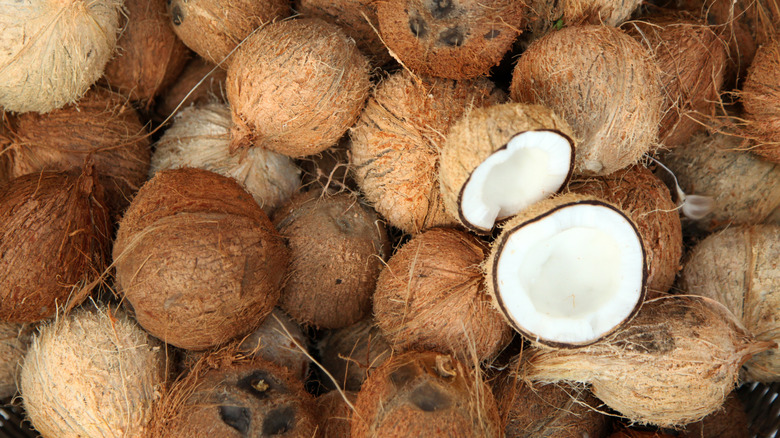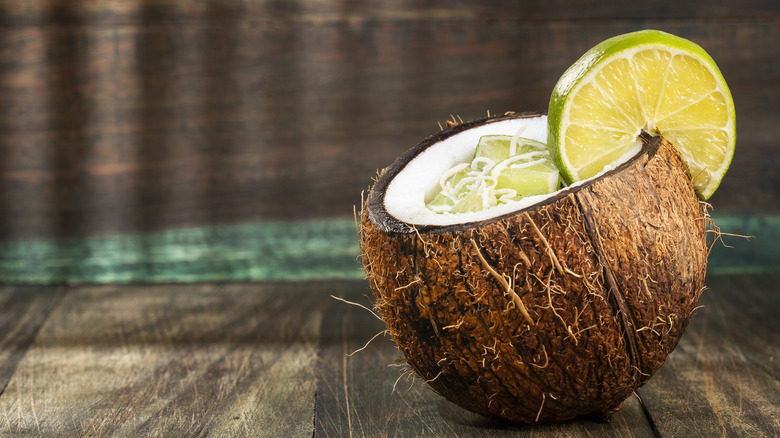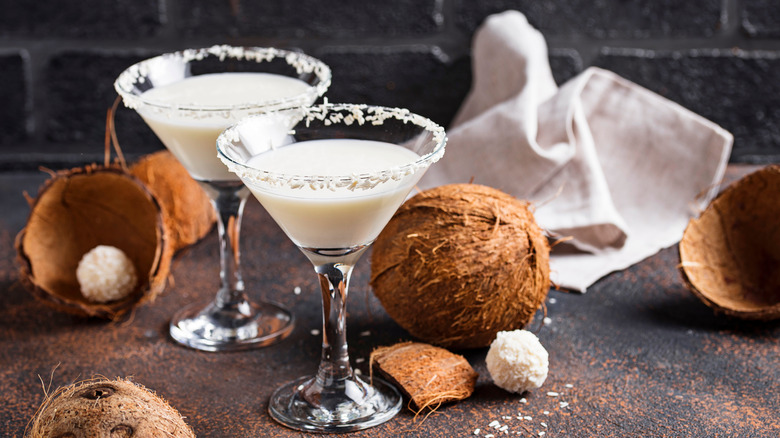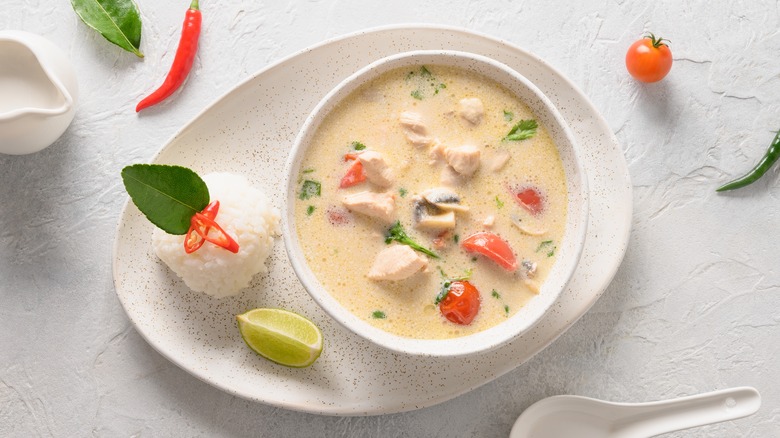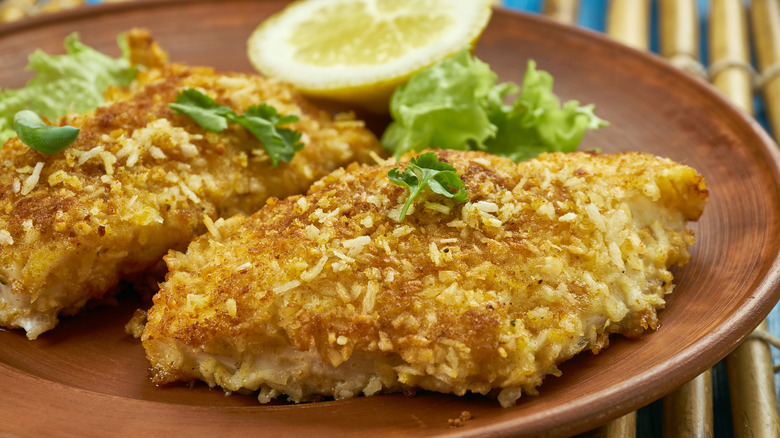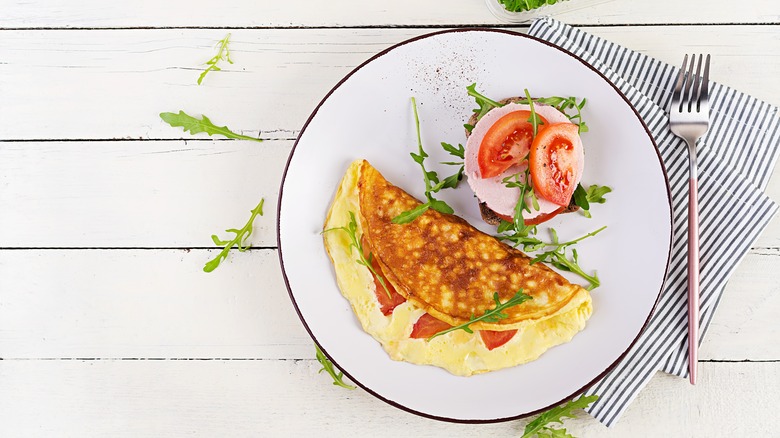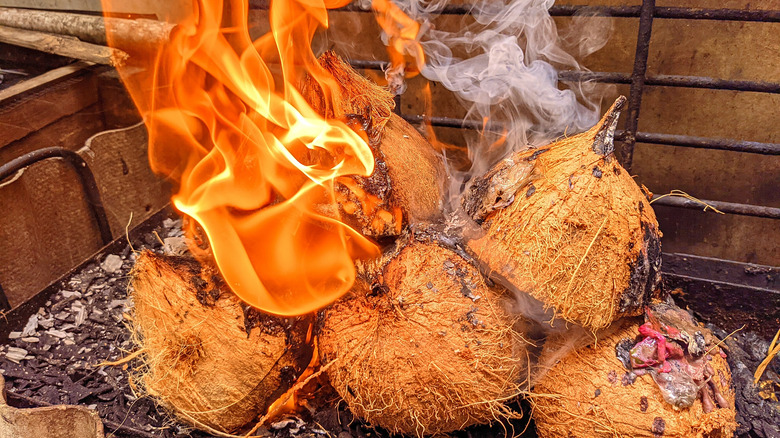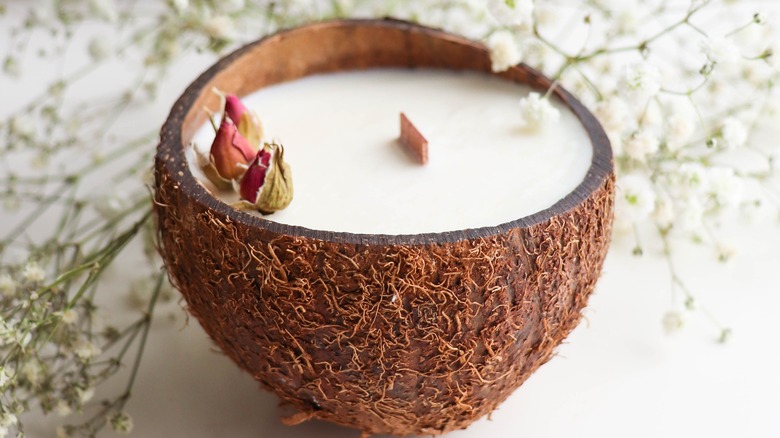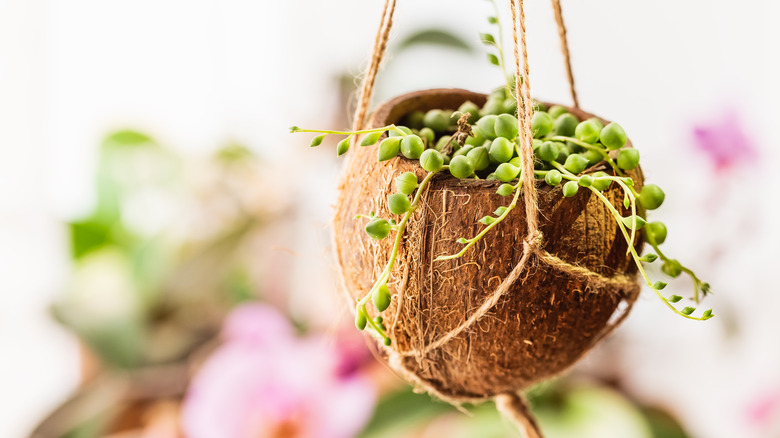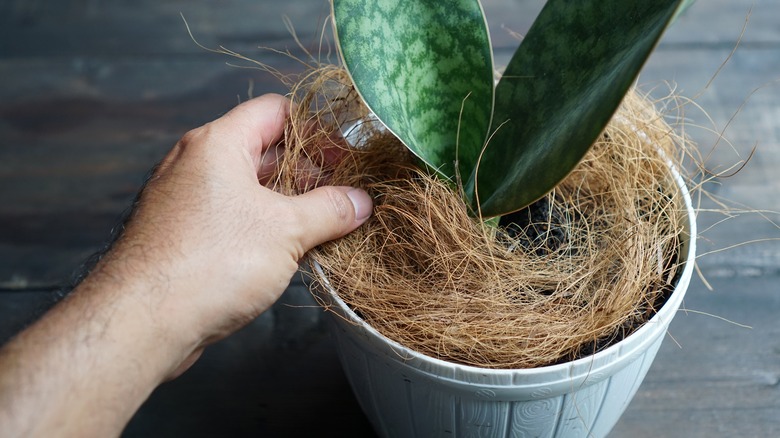11 Creative Ways To Use A Whole Coconut
You may have baked cookies using coconut flour or sipped from a brightly-branded bottle of flavored coconut water, but have you ever come face-to-face with a whole fresh coconut? Since coconut products are so widely available to modern consumers, we may skip past these notoriously fuzzy brown orbs in search of something conveniently pre-packaged.
You might pick up a coconut and feel completely baffled, wondering how the heck you'll even get it open. Don't let these hard-shelled fruits intimidate you. Coconuts are incredibly versatile fruits that, for centuries, have been used for more than just tropical cocktails and coconut cream pies. There are countless ways to cook with the raw meat and water found inside coconuts, and there are plenty of uses for the fruit's outer shell and husk.
If you're a real food fiend like New York City's Chef Harold Moore, you like your meals to have a little culinary integrity. The acclaimed Chef Moore is no stranger to making the most of fresh, whole coconuts and is even well-known for his famous coconut cake — a decadent dessert whose proceeds support the Make-A-Wish-Foundation. If you wish to discover what you can do with a whole coconut, read further to learn Chef Moore's creative tips and tricks for utilizing every part of the fruit in the fashion of a true coconut connoisseur.
1. Make your own bowl
Most of the coconuts you'll find in stores are about the size of a large grapefruit. This means that the shell, when split in half, makes for a perfectly-sized, hand-held bowl. You can open a coconut by whacking it really hard against something, but if you want to wind up with a nice-looking bowl, Chef Moore recommends (carefully) using a hand-held saw to cut off the top of the fruit.
For a lovely, well-plated dinner that'll minimize your dishwasher load, Chef Moore suggests filling the coconut with cooked rice, raw shrimp, jalapeño, and a little cilantro before wrapping it in foil and heating it over a fire for around 20 minutes. With this method, the coconut meat gets cooked and steamy, infusing all ingredients inside it with its subtly sweet, nutty flavor.
If you're already planning to use the inside of your coconut for other recipes, you can save your coconut shell and make a fully-functioning, reusable bowl. As Mashed reports, you'll want to thoroughly clean and sand the shell, so it's smooth before coating it with a lacquering finish to make it presentable and waterproof. No expensive ceramics can beat the satisfaction of eating out of a dish you made yourself!
2. Serve eye-catching cocktails
You've probably seen movies featuring swimsuit-clad people lounging on pristine, sandy beaches sipping on umbrella straws straight out of coconut shells. This picturesque luxury isn't only reserved for tropical vacation-goers! If you've got a coconut, there's no reason you can't fashion a fancy cocktail out of it. Whether you're hosting a luau-like party or simply want to treat yourself to something special, using a coconut as a cocktail glass is always a delight.
If you're going to serve a drink out of a coconut, you're almost obligated to make sure that it's a pina colada — although a creamy coquito would work perfectly for the holidays. Use your fresh coconut meat to make a classic pina colada, and keep half the shell as a perfectly on-theme receptacle. Chef Moore suggests adding a splash of Maraschino liqueur for some extra flavor, and he urges: "don't forget an umbrella for your drink!"
3. Garnish anything
When you crack open a whole coconut, you can use a spoon to separate the meat from the furry outer husk. It'll likely have a thin brown skin on the outside, which you can remove with a vegetable peeler, as per Chef Moore. Then what? Chef Moore says that "you'll get large, randomly shaped chunks of coconut meat from a whole coconut," so a smart way to make the meat into a more usable form is to shred it with a box grater.
With fresh, unsweetened shreds of coconut, the options are nearly endless. You can go the obvious route and use these flakes as a garnish for coconut-based cocktails or atop tropical smoothie bowls. A sprinkle of shredded coconut can also add a super subtle yet refreshing hint of flavor atop spicy soups or hearty stews. Even simple dishes like cereals or salads can benefit from a bit of coconut, which always makes for a lovely presentation. In fact, Chef Moore says that puréeing fresh coconut meat makes an awesome emulsifier for a coconut vinaigrette. Baking a cake? Whether or not there's coconut in it already, coconut shreds stick to frosting and make the perfect, eye-catching garnish.
What's great about using fresh coconut is that you can adapt it to suit your needs. Shred it, add sugar to it for sweetness, or toast it in the oven for the perfect bit of crunch — whatever dish you're serving, there's likely room for some coconut!
4. Use it as an animal product substitute
Fresh coconut meat has a refreshing, subtly sweet, subtly nutty flavor and a fleshy texture that can be gelatinous or a bit tougher, similar to a not-quite-ripe mango. As per Healthline, coconut meat contains some protein but plenty of fats, making it a fairly filling food. As such, Chef Moore points out that coconut meat can be a delightful, lighter-tasting alternative to animal meats, especially in dishes like tropical stews.
While chunks of coconut flesh can be eaten as meat substitutes, Chef Moore also likes to dehydrate strips of coconut meat sprinkled with lime and other spices for a plant-based jerky alternative. Of course, there's also the option of using coconut flesh to create creamy, sweet coconut milk. Chef Moore says to grind or blend the coconut flesh and water before straining the mixture with cheesecloth to extract all of the milk. Voila, you've got fresh coconut milk! Use coconut milk in place of dairy milk in your coffee, add a fatty richness to spicy curries, or even bake lactose-free goodies with it.
5. Add flavor to fried foods
If you're looking for an easy way to shake up boring weeknight meals or just an excuse to use your air fryer, you might want to consider adding some coconut flakes. While the Daily Meal notes that coconut oil works great for deep-frying, Chef Moore likes to take things a step further. "Unsweetened, fresh coconut shaved or grated makes an excellent crust for fish," he says, adding that it provides a "toasty," "nutty" coconut flavor without adding too much sweetness to the final dish.
Whether you're making savory chicken, a succulent fish filet, or classic coconut shrimp, it's super simple to include coconut into any standard breading or coating. Simply dunk your protein in eggs and flour like you normally would and add coconut flakes to your breadcrumb mixture. Chef Moore says to "toss the coconut in a little cornstarch" for the best extra-crispy results.
6. Upgrade your omelets
Yes, you read that right! You may not think coconut has a place in your omelet but think again. If you've ever tried to create a perfectly-textured, fluffy omelet, you may have tried whisking some cream or milk into your egg mixture. Thanks to Mashed, we know that regular cow's milk can make your omelets slightly watery since it doesn't blend fully with eggs.
On the other hand, coconut milk mixes well with eggs and even adds a bit of nuttiness to the flavor. Chef Moore even considers coconut a great "emulsifier," meaning that it acts as a blending agent in various recipes. In the end, an omelet made with coconut milk tends to be rich and creamy thanks to the naturally high-fat content found in coconut milk. If you're using a whole coconut, all you have to do is blend together the coconut meat and water. Strain it well and you've got fresh, flavorful coconut milk perfect for your next breakfast!
7. Add it to your beauty routine
You can harvest coconut meat, water, and milk directly from a whole coconut, using them for a wide variety of tasty recipes. Coconut itself boasts plenty of nutritional value, whether you munch on the mineral-rich meat or sip its ultra-hydrating water. Coconut isn't just beneficial when ingested; it's a common ingredient in cosmetic products as well.
You can make coconut oil yourself by using a somewhat-lengthy heating process that involves blending coconut meat and heating it until the oil begins to separate and solidify (via Alpha Foodie). Mashed reports that store-bought coconut oils are often made using methods that can diminish their nutritional properties, so it's always nice knowing you've made something free from harsh chemicals or mysterious additives.
Coconut oil can be used for cooking, but it has historically been used in beauty regimens thanks to how it nourishes hair and skin. Health-centric media outlet Prevention notes that coconut oil contains fats and other properties that make it a hydrating, anti-inflammatory product used to make skin and hair soft and smooth.
8. Smoke meats with extra flavor
When you've made lots of tasty dishes with your coconut meat, water, and milk, you'll typically be left with the hard, hairy coconut shell. Though you won't want to try eating this fibrous husk, it's worth keeping since it has many practical uses.
One such creative use for coconut husks is meat smoking. According to Chef Moore, you can swap out your usual wood chips or charcoal for discarded coconut shells when smoking meats. They'll burn and create the smokiness you need while infusing your meats with a rich, fatty, toasted nut flavor. Reddit user shroomenheimer confirms that this effective smoking method gives the meat a distinctly coconutty flavor that can't be replicated!
Combining coconut husks and other wood chips is also fine to do. If you plan to use your leftover coconut shells to smoke meats, having some extra wood or charcoal on hand is ideal just in case your coconuts burn out too quickly.
9. Make a tropical candle
Similarly to how you can smooth and sand a coconut shell to make a picture-perfect bowl, you can use a cleaned coconut shell as an impressive novelty candle holder. Eco-friendly home goods seller Jungle Culture shares an easy how-to guide for making coconut shell candles right at home.
On their blog, they share that you'll first want to cut your coconut in half and remove all of the meat and water from inside — saving it for tasty recipes, of course! Then, they instruct to thoroughly sand the outside of the shell to be uniformly smooth. Make your own custom-scented candle wax using a kit, pour it into the coconut shells, let it set, and you're done! You can even add coconut oil to your wax mixture for a refreshing tropical scent. With the purchase of one coconut, you'll get to enjoy plenty of fresh coconuts, and you'll have two one-of-a-kind candles that make the perfect gift or DIY project.
10. Pot your plants
Round, sturdy, durable, and long-lasting, there are plenty of practical uses for coconut shells. You can eat and drink out of them, bang them together to make music, or string them together for a classic bikini top. If you've got plenty of bowls and cups and bikini tops, you can use your leftover coconut shells for a more rewarding purpose: as pot planters!
Just like you would when making any kind of coconut home decor, you'll want to clean out the inside of the shell and thoroughly sand the fibers off of the outside — save these fibers for your plant soil. Once you've got a smooth, clean coconut shell, you can use it as a fully-functioning plant pot. Choose the shell half with the distinctive three holes, which are known as "eyes." Poke each eye with a screwdriver to allow the pot to drain, and there you have it: a naturally occurring, biodegradable plant pot that's bound to impress any garden guest (via Rural Sprout).
11. Improve your garden soil
As per Tasting Table, native Filipinos refer to the coconut tree as the "Tree of life," thanks to its numerous and beneficial uses. We think that "Tree of life" is a suitable nickname for this plant, especially since coconuts can be used to nourish the soil and help plants grow, according to the green-thumbed garden enthusiasts at Gardening Know How.
One gardener shares on Gardening Know How that the distinctive little hairs on coconut shells — known as coconut coir — make for a supremely beneficial mulch alternative that can help the soil retain necessary nutrients and water. They also note that using coconut-derived coir mulch rather than common mulches like peat moss is better overall for the environment. Coconut coir can be purchased in stores or online, but you can toss the discarded fibers from your own coconut into any soil or plant to reap these benefits!
